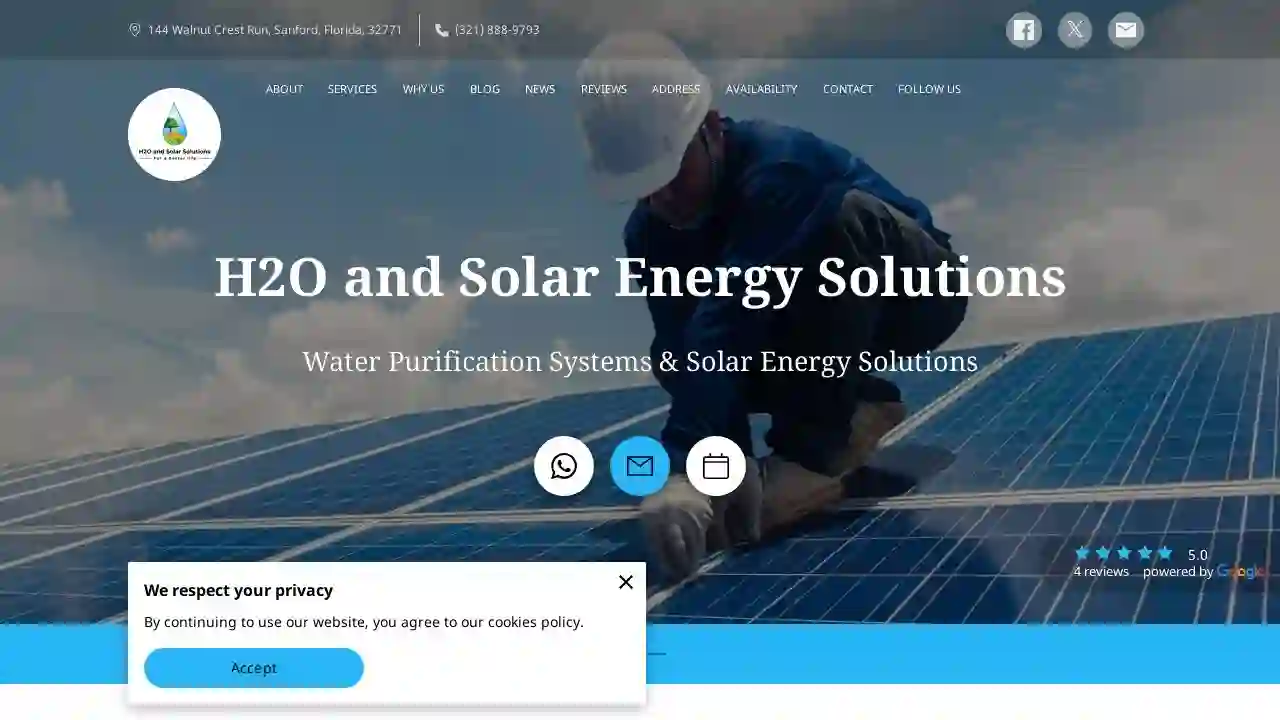Solar Installers Dania Beach
Find top Solar Energy Company in Dania Beach
Receive multiple Solar Installer quotes for your project today! Compare profiles, reviews, accreditations, portfolio, etc... and choose the best offer.

Solar-Ray
4.6122 reviewsOrlando, FL, 6007 Anno Ave, 32809, USSolar-Ray, Inc. is the first NABCEP Accredited PV Installation Company in Florida and has over 19 years of experience. We specialize in solar panel sales, design, installation, and service. Our commitment is to the best PV equipment available. We are committed to superior customer service and to provide the best PV equipment available at the lowest price possible.
- Services
- Why Us?
- Accreditations
- Our Team
- Testimonials
- Gallery
Get Quote
Solar Geotechnical Testing
Miami, Florida, 33101, USSolar Geotechnical Testing is a skilled solar and geotechnical testing contractor that provides on-site subsurface conditions and pile performance data for photovoltaic panels. They work directly with engineers to ensure pre-construction assessments are conducted and accounted for.
- Services
- Why Us?
- Gallery
Get Quote
Uptown Energy Solutions
4.610 reviewsOrlando, Florida, 424 East Central Blvd, 32801, USUptown Energy Solutions is a full-service commercial solar company based in Orlando, Florida. They aim to accelerate the adoption of solar energy by reducing the anxiety of making a large investment. Their mission is to arm clients with unbiased knowledge, superior products, and personal support to make their solar future bright. They offer a range of services including feasibility study, team selection, and execution.
- Services
- Why Us?
- Accreditations
- Our Team
- Testimonials
- Gallery
Get Quote
LAZEN Solar
542 reviewsOrlando, FL, 123 Solar Street, 32801, USLazen Solar, a premier solar company based in Orlando, Florida, offers top-tier residential solar solutions, positioning itself as a leader in the region's renewable energy sector. Their expertise in solar energy systems has made them a go-to choice for Orlando residents seeking to transition to solar power. With a strong commitment to quality and customer satisfaction, Lazen Solar is dedicated to helping homeowners harness the abundant solar energy available in Orlando.
- Services
- Why Us?
- Accreditations
- Our Team
- Testimonials
- Gallery
Get Quote
Solar Scott
123 Solar Street, Fort Lauderdale, FL, 33301, USAll Phase Solar Panels Fort Lauderdale is a full-service solar company that has been providing quality solar services to residents of Fort Lauderdale, FL for years. We are dedicated to helping our customers save money and reduce their carbon footprint by installing high-quality solar panels on their homes and businesses. We offer a wide range of solar services, from residential installation to commercial installation, and we are always here to help our customers find the best solution for their needs.
- Services
- Why Us?
- Gallery
Get Quote
TruSolar
Daytona Beach, FL, 123 Solar Way, 32127, USTruSolar is a leading provider of direct-to-installer residential solar solutions, offering flat-rate pricing, top-tier equipment, and dedicated technical support. With operations in 18 states, they provide a 60-second instant quote, a 25-year parts warranty, and a 10 or 25-year service warranty. Their mission is to help hundreds of people go solar and save money on their electric bills.
- Services
- Why Us?
- Accreditations
- Our Team
- Testimonials
- Gallery
Get Quote
ProSolar Systems Florida
55 reviewsWilton Manors, FL, United States, 1100 W Oakland Park Blvd Unit 8, 33311, USProSolar Florida is a leading provider of solar energy solutions, offering a range of services including residential and commercial solar energy, net metering, roof installation, solar reinstallation, Tesla Powerwall certified installer, Tesla Solar Roof, and Duracell Powercenter. With a focus on sustainability and energy independence, ProSolar Florida aims to help individuals and businesses transition to cleaner energy sources.
- Services
- Why Us?
- Accreditations
- Our Team
- Testimonials
- Gallery
Get Quote
AXIOS SOLAR USA, LLC
Miami, FL, 1234 Solar Street, 33101, USAXIOS SOLAR USA, LLC is known for its authentic commitment in the implementation of alternative energies, especially with the use of SOLAR ENERGY and WIND GENERATION, for the satisfaction of our clients, always focused on our conviction of a better future for all.
- Services
- Why Us?
- Accreditations
- Our Team
- Gallery
Get Quote
H2O and Solar Energy Solutions
54 reviewsSanford, Florida, 144 Walnut Crest Run, 32771, USH2O and Solar Energy Solutions is a family-owned business that specializes in providing sustainable solutions for water purification and solar energy in Central Florida. They offer a fantastic water purification system that provides clean, purified, and alkaline water, ensuring that your loved ones have access to safe drinking water. Additionally, they provide solar energy solutions that are not only good for the environment but also help reduce energy costs. Their services are available 24/7 by appointment only, and they offer a 24-hour delivery service and free consultation.
- Services
- Why Us?
- Testimonials
- Gallery
Get Quote
Smart Energy Experts
12 reviews9000 Sheridan St, Ste 130, Pembroke Pines, 33024, USSmart Energy Experts is one of the leaders in the Renewable Energy industry including Solar which grew out of an environmental consciousness and a love of American built products. As our place in the world evolves our needs to be energy independent becomes central to building a strong safe America.
- Services
- Why Us?
- Accreditations
- Our Team
- Testimonials
- Gallery
Get Quote
Over 4,210+ Solar Contractors onboarded
Our solar providers operate in Dania Beach & beyond!
SolarCompaniesHub has curated and vetted the Best Solar Installers in Dania Beach. Find a top & trustworthy pro today.
Frequently Asked Questions About Solar Installers
- Adequate Sunlight: Unobstructed sunlight for a significant portion of the day.
- Sufficient Space: Enough space to accommodate the desired number of panels.
- Structural Integrity: A strong roof structure capable of supporting the weight of the panels.
- Appropriate Orientation and Tilt: Ideally, the roof should face south (in the Northern Hemisphere) or north (in the Southern Hemisphere) with a tilt angle close to the latitude of your location. However, other orientations and tilts can still be effective.
- Monocrystalline: Made from a single silicon crystal, known for high efficiency (typically 18-22%) and sleek black appearance.
- Polycrystalline: Made from multiple silicon crystals, slightly less efficient (15-17%) but often more affordable than monocrystalline.
- Thin-film: Made from thin layers of photovoltaic material, lower efficiency (8-12%) but can be flexible and lightweight.
- Tax Credits: Reduce your income tax liability based on the cost of your solar system.
- Rebates: Direct cash payments or discounts on the purchase of a solar energy system.
- Net Metering: Allows you to sell excess solar electricity back to the grid for credits.
- Renewable Energy Certificates (RECs): Tradeable credits representing the environmental attributes of your solar energy generation.
How do I know if my roof is suitable for solar panels?
What is net metering, and how does it work?
What are the different types of solar panels?
Are there any financial incentives for going solar?
How do I know if my roof is suitable for solar panels?
- Adequate Sunlight: Unobstructed sunlight for a significant portion of the day.
- Sufficient Space: Enough space to accommodate the desired number of panels.
- Structural Integrity: A strong roof structure capable of supporting the weight of the panels.
- Appropriate Orientation and Tilt: Ideally, the roof should face south (in the Northern Hemisphere) or north (in the Southern Hemisphere) with a tilt angle close to the latitude of your location. However, other orientations and tilts can still be effective.
What is net metering, and how does it work?
What are the different types of solar panels?
- Monocrystalline: Made from a single silicon crystal, known for high efficiency (typically 18-22%) and sleek black appearance.
- Polycrystalline: Made from multiple silicon crystals, slightly less efficient (15-17%) but often more affordable than monocrystalline.
- Thin-film: Made from thin layers of photovoltaic material, lower efficiency (8-12%) but can be flexible and lightweight.
Are there any financial incentives for going solar?
- Tax Credits: Reduce your income tax liability based on the cost of your solar system.
- Rebates: Direct cash payments or discounts on the purchase of a solar energy system.
- Net Metering: Allows you to sell excess solar electricity back to the grid for credits.
- Renewable Energy Certificates (RECs): Tradeable credits representing the environmental attributes of your solar energy generation.